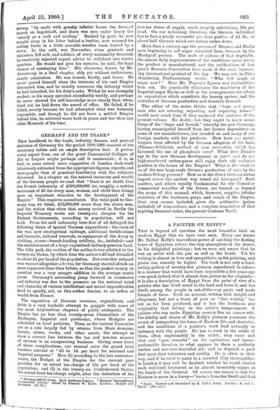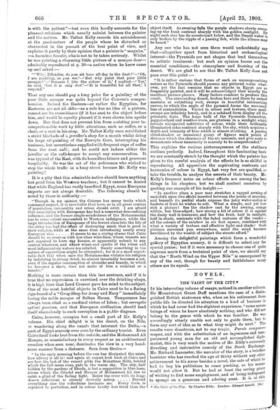A PAINTER ON EGYPT.*
THIS is beyond all question the most beautiful book on modern Egypt that we have ever seen. Every one knows Mr. Talbot Kelly's marvellous power of catching the fleeting tones of Egyptian colour, the very atmosphere of the desert, in his delightful paintings ; but we were not aware that he was an artist with the pen as well as the brush. Yet his writing is almost as true and sympathetic as his painting, and praise can scarcely be higher. The book is not only a fasci- nating gallery of seventy-five pictures reproduced in colours in a manner that would have been impossible a few years ago —so good, indeed, that it almost does justice to the originals— it is also a description of Egypt from the point of view of a painter who has lived much in the land and loves it, and has dwelt among the people in out-of-the-way parts and made friends of them. Such an account, written with insight and eloquence, but not a trace of pose or " fine writing," has not so far been produced, and it has the freshness and originality that belong to the artist's temperament. A painter who can make Egyptian scenery live on canvas with the fidelity and charm of Mr. Kelly's pictures possesses the secret of interpreting the tones of Eastern life and character, and the conditions of a painter's work lead naturally to intimacy with the people. He has to work in the midst of them, often unpleasantly in the midst ; they come and chat and "pass remarks" on his mysterious and incom- prehensible devotion to what appears to them a perfectly useless and not even beautiful art; and he depends a good deal upon their toleration and civility. He is often in their way, and if he tried to paint in a crowded City thoroughfare in London it may well be doubted whether he would receive such well-bred treatment as he almost invariably enjoys at the hands of the Oriental. Of course one reason is that the Eastern is never in a hurry—" haste is from the Devil and God * Egypt. Painted and Described by B. Talbot Kelly. London : A. and C. Black. [Ms. uet.1
is with the patient "—but even this hardly accounts for the pleasant relations which usually subsist between the painter and the natives. Mr. Talbot Kelly records his astonishment
at the good-nature of the people whom he disturbed or obstructed in the pursuit of the best point of view, and explains it partly by their opinion that a painter is " magnfin," —a harmless lunatic, who is not to be taken seriously. Whilst he was painting a charming little picture of a mosque door—
admirably reproduced at p. 30—a native whom he knew came up and asked :—
" WItr, Effendim. do you sit here all day in the dust ?'—` Oh, I am painting, as you see.'= But why paint that poor little mosque ?'--4 Because I like the colour of it,' I replied.= Yes,' be said, `but it is only dirt'—`It is beautiful for all that,' I respond."
That any one should pay a long price for a painting of the poor little mosque was quite beyond the Cairene's compre- hension. Indeed the Eastern—or rather the Egyptian, for Easterns are not all alike—as a rule has no idea of a picture, cannot see its resemblance (if it has one) to the object before him, and would be equally pleased if it were shown him upside down. But that does not prevent him from assisting your in- comprehensible work by little attentions, such as coffee, or a chair, or a seat in his shop. Mr. Talbot Kelly once established a strict blockade of a jeweller's shop for a month whilst doing his large oil-painting of the Zuweyla Gate, interrupting his business, but nevertheless supplied with frequent cups of coffee from the next cafe ; and he could not induce either the jeweller or the cafe-keeper to accept any remuneration. It was typical of the East, with its boundless leisure and generous hospitality. So was the act of the policeman who wished to stop the whole traffic in a busy street because Mr. Kelly was painting !
It is a pity that this admirable native should learn anything but good from his Western teachers ; but it cannot be denied that while England has vastly benefited Egypt, some European imports are not always desirable. The following should be noted by those in authority :—
"Though in my opinion the Cairene has many traits which command respect, it is inevitable that here, as in all great centres of population. immorality and crime should exist. I am afraid that association with Europeans has had a somewhat demoralising influence, and the former single-mindedness of the Mohammedan has to some extent succumbed to Western indulgence, while the large introduction of Europeans of the lowest class into the life of the cities has had the effect of destroying much that is good in their religion, while at the same time introducing nearly every European vice It seems to me a crying shame that Cairo should be so overrun with low-class wine-bars, whose tenants are not required to have any license, or apparently submit to any control whatever, and where wines and spirits of the vilest and most inflammatory nature are retailed. Surely something in the nature of supervision might be attempted ; for it is a most regret- table fact that when once the Mohammedan violates his religion by indulging in strong drink, he almost invariably becomes a sot, even if the regular consumption of absinthe and brandy, to which he becomes a slave, does not make of him a criminal or a lunatic."
Nothing is more certain than this last sentence, and if it is trim that no supervision is exercised over the drinking shops, it is high time that Lord Cromer gave his mind to the subject. One of the most hateful objects in Cairo used to be a flaring sign-board of a " Grog-Shop for Army and Navy " immediately facing the noble mosque of Sultan Masan. Temperance has always been cited as a cardinal virtue of Islam ; but corruptio optimi pessima, and that European civilisation should lend
itself shamelessly to such corruption is a public disgrace. Cairo, however, occupies but a small part of Mr. Kelly's volume. His chief delight is in the desert, on the Nile, or wandering along the canals that intersect the Delta,—a
part of Egypt scarcely ever seen by the ordinary tourist. Even Cairo itself looks best from the outside, and the Mohammed Ali Mosque, so unsatisfactory in every respect as an architectural creation when seen near, dominates the view in a very hand- some manner from a distance. Seen from Gezira-
" In the early morning before the sun has dissipated the mists, how silvery it all is ! and again at sunset look back at Cairo and see how the last of the sunset gilds the Mokattam Hills, behind which the full moon rises, pale in the warm sky. The city, half hidden by the gardens of Rhoda, is but a suggestion in blue haze, above which the Citadel and Mosque of Mohammed Ali rise to catch a glint of the fading light. Below the river with its long-
drawn reflections is already drowsily asleep Beyond everything else the reflections fascinate me. Every form is repeated to perfection, and in colour hardly less vivid than the
object itself. As evening falls the purple shadows slowly creep, ing up the bank contrast sharply with the golden sunlight. By night each star has its counterpart below, and the limpid water is only broken by the ripple of a passing fish, while the silence may be heard."
Any one who has not seen them would undoubtedly say that—altogether apart from historical and archaeological
interest-the Pyramids are not shapes that lend themselves to artistic treatment : but such an opinion leaves out the essential conditions,—the atmosphere and framing of the desert. We are glad to see that Mr. Talbot Kelly does not pass over this point :-
"It is rather curious that forms of such an uncompromising nature as the Pyramids should possess any pictorial value what- ever, yet the fact remains that no objects in Egypt are so frequently painted, and it will be acknowledged that usually the resultant picture pleases. Many factors combine to produce this result. The strrounding desert, broken here and there by ruined mastaba or ontjutting rock, sweeps in beautiful intersecting curves, to which the angle of the pyramid forms the necessary line of contradiction. Varied in colour and texture, these sand- sweeps are infinitely lovely, and in a subdued form display all the prismatic tints. The huge bulk of the Pyramids themselves, jagged-edged and weather-worn, are glorious in a sunlight which reveals unexpected subtleties of colour, while their brilliantly illuminated sides contrast sharply with the sky, which acquires a depth and intensity of blue which is almost startling. A passing cloud-shadow or occasional group of figures mark points of distance which the clearness of the air conceals, and give scale to monuments whose immensity is scarcely to be comprehended."
This explains the curious picturesqueness of the stubborn outlines perfectly. Indeed, throughout this fascinating book we are constantly struck by the thought whioh the painter has given to the careful analysis of the effects he is so skilful in reproducing. All appreciate the captivating contrasts and harmonies of colour in Egypt, but very few are qualified, or take the trouble, to analyse the secrets of their beauty. Mr. Kelly's frequent notes on colour effects are among the best things in his chapters, but we shall content ourselves by quoting one example of his insight:— "In another place a poor man stretches a ragged awning of sackcloth upon two sticks inserted between the joints of masonry, and beneath its partial shade exposes the juicy water-melon or baskets of fruit he wishes to sell. What a simple, and yet how rich a picture! See the shadow cast by the awning, orange within, but blue-edged ; how strong a bit of colour it is against the dusty wall it traverses, and how the fruit, half in sunlight, half in shade, contrasts with the faded costume of the vendor— all the colours of the rainbow in six feet square, combined with what a variety of texture and effective light and shade ! Such pictures surround you everywhere, until the mind becomes bewildered by the wealth of subject the streets afford."
Among the delightful paintings which form a wonderful gallery of Egyptian scenery, it is difficult to select any for special praise; but if it were necessary to choose one of quite supreme merit from a technical point of view, we should say that the "North Wind on the Upper Nile" is unsurpassed by any of the rest, though for beauty and faithfulness many
others are its equals.



























































 Previous page
Previous page